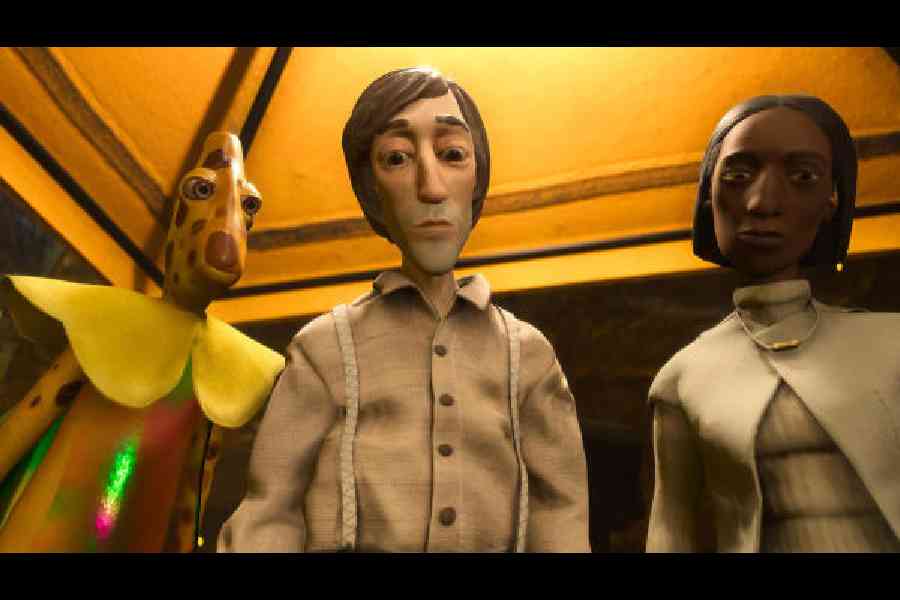Ahandmade video game sounds like an oxymoron, like a rock opera or a TV movie. But on rare occasions, designers choose to build their interactive worlds not from pixels and polygons but from materials like cardboard and clay.
For his haunting 2013 puzzle game The Swapper Olli Harjola sculpted sets and characters out of Plasticine and then digitised them using photogrammetry.
Harjola had no idea how to programme 3D models, so working with real stuff felt like an easier entry point. The same was true for Slow Bros., a studio in Cologne, Germany, that’s behind Harold Halibut, which released recently for the PC and PlayStation and Xbox consoles.
Fourteen years ago, fresh out of film school, Onat Hekimoglu had an idea for a game about a hapless janitor stuck in an undersea city on an alien planet after his ancestors fled from a calamity back on Earth. The scenes he imagined were visually ambitious, but he had no experience building things digitally. So he and his friends chose to work around the skills they did not have (coding, 3D modelling) in favour of those they did (carpentry, sculpture, lighting, costume design).
Soon Hekimoglu, Harold Halibut’s director and designer, enlisted Ole Tillmann, who became the game’s art director and puppetmaker. Tillmann attended the Rhode Island School of Design, US, where his instructors had emphasised making things by hand.
The designers built nearly everything, including clay characters and adorably miniature costumes sewn from real textiles. They built walls from real minuscule bricks fastened with real mortar. To weather sets, they would leave them out in the rain, or allow them to collect dust for weeks, or accelerate rust with a special spray.
At first, Slow Bros. thought it would animate Harold Halibut using traditional stop-motion techniques. But the studio was unhappy with an early prototype and set off on a journey of experimentation. Eventually, the designers devised a novel solution: they made detailed 3D scans of their handmade puppets, props and set pieces before importing them into the video game engine Unity and using motion capture to bring the characters to life.
Few game developers have taken this hybrid route. “It’s not a very reasonable thing to do,” said Jakub Dvorsky, the founder of Amanita Design, whose forthcoming game Phonopolis is digitally animated from scans of hand-painted paper and cardboard. “So it needs a developer who’s driven, passionate, a little crazy.”
The handmade approach is not the reason Harold Halibut took more than a decade to produce, Hekimoglu said. Funding is what slowed them down. With little money but plenty of time, the team pursued creative puzzles just for the fun of it, making water animations from scratch instead of importing a premade asset.
Narratively, Slow Bros. was inspired by a genre of games known as walking simulators, such as Dear Esther and Firewatch, whose interactivity is less about gameplay and more about pursuing a story by exploring an environment. But the studio’s frame of
reference was not centred on video games; Tillmann singled out inspirations
like Archigram and Ant Farm, two avant-garde architecture collectives.
Harold Halibut is teeming with details and detours. If you opt to sit down and watch a tiny television in a break room, you can catch eight minutes of a surreal, unsubtitled Turkish-language telenovela the developers wrote, built from clay and animated from scratch.
The game, including the telenovela, is fully voice-acted by a large cast of actors. But when Slow Bros. recorded motion capture to map physical performances onto its clay puppets, Hekimoglu played every character himself — an impressive feat of acting given the game’s variety of personalities. This spared him from having to painstakingly explain to actors how to move and where to look without the benefit of life-size sets as a reference point. “I have the entire game in my mind,” he said.
Harold Halibut’s handmade quality dovetails with its story and ideas. In the characters’ attempts to escape the planet they are stuck on, they are trying to build a solution with the materials they have on hand, just like the game’s own designers. The deliberately imperfect aesthetic also syncs nicely with Harold Halibut’s vision of futuristic tech: despite the incessant hype of tech corporations, the gear the characters produce is often unreliable or disappointing.
“Usually games want to make you the hero,” Hekimoglu said. “We liked the idea of things not working, things failing, and maybe not reaching your goals.”
NYTNS











